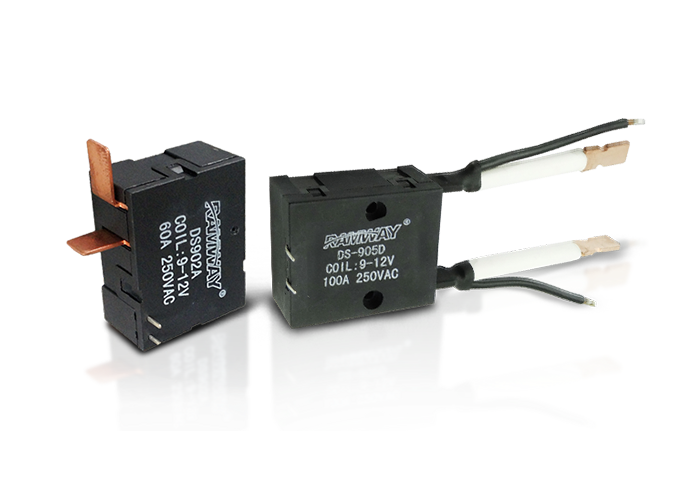Introduction to Single Phase Latching Relays
Elecorev Ramway’s Magnetic Latching relays is advanced relays developed in recent years. Latching relays is an automatic switch, like other electromagnetic relays it can switch on and off from the circuit automatically using the pulse. The difference between Latching relay and electromagnetic relay is that, normally open and normally closed state of magnetic relay completely depends on the action of the permanent magnet, and the state of the contacts of latching relays is triggered with the certain width of the pulse electric signals.
Magnetic latching relays are available in different phase i.e. single phase, dual phase and three phase. Our relays offers maximum switching upto 120Amps and operating voltage of the control coil is divided into DC6V, DC9V and DC12V and DC24V etc. Generally the electrical life of the relay is 10000 Cycles and Mechanical life of the relays is 100000 times.

Therefore, It posses a strong characteristics of power saving, operating in stable performance, smaller in size, large current bearing capacity and superior performance than general electromagnetics relays.
Magnetic latching relays are generally used in Smart IC card prepaid meters, Smart Electricity Meters and Automatic meter Centralized system. In last few years, Magnetic latching relays have been used in the composite switch of reactive power compensation device. In combination with the MOSFETS, it becomes the main switching device in reactive power compensation device to switch large current circuits. It is also applicable in various household applications and automatic control devices such as lighting control systems.
Principal of Latching Relays
with the magnetic force generated by permanent magnet in the magnetic relay it hold the open and closed state of the relays. When the relay contacts need to be opened and closed (i.e. to connect or disconnect the load), the relay can transit from open state to close state and vice versa using positive (Negative) DC pulse voltage to excite the coil. The power loss during the transition is generally less than 1W. Generally, When the contact of the relay is in hold state it doesn’t require to continue it to be energized and the state of the relay can easily be maintained by magnetic force of the permanent magnetic steel.
Structure of magnetic latching relay
Structure of magnetic latching relay
The magnetic latching relays re seprated into two layers, The lower layer is the contact system and the upper layer is electromagnetic system. The electromagnetic systems posses the flat direct imposed magnetic circuit system which includes coil, magnet, armature, iron core and the mounting plate and the coils are installed on the both sides of the magnet.
The magnetic latching relay is divided into two layers, the upper layer is the electromagnetic system, and the lower layer is the contact system. The electromagnetic system adopts the flat direct acting magnetic circuit system, which includes magnet, coil, armature, iron core and mounting plate. The magnet is located in the center of the mounting plate, and coils are installed on both sides of the magnet. The U-shaped iron core is set above the coil, and the armature is in the iron core to form an annular structure It can be controlled by magnetic field. Both ends of the mounting plate are located beside the U-shaped bottom of the iron core, and a pure iron plate is also installed to prevent the interference of external magnetic field.
Principle of magnetic latching relay
The open and closed state of the magnetic latching relay is usually held by the magnetic force generated by the permanent magnet. When the contacts of the relay need to be opened or closed (i.e. when the load is connected or cut off), the relay can complete the state transition of opening and closing in an instant by using the positive (negative) DC pulse voltage to excite the coil. The power loss is generally less than 1W. Usually, when the contact is in the hold state, the coil does not need to continue to be energized, and the state of the relay can be maintained only by the magnetic force of the permanent magnetic steel.
Advantages of Single Phase Latching Relays
Precaution for Magnetic Latching Relays
1. When the relays are shipped from the factory it is usually contact closed, but due to many factors it changes its state from closed to open during transportation or during relay installation. Therefore, it is necessary to reset the contacts before use.
2. In order to operate the relay reliably, the applied voltage to the coil must reach the rated voltage and pulse width should be more than 3 times of the operating voltage.
3.Magnetic latching Relays are coils polar differentiated and the polarity of the coil must be specified during the time of order.
4.The size, shape and installation size of the magnetic latching relays can not be changed generally. During the selection of Latching relays proper attention is to be paid to weather relay size and shape meets the requirement. The other terminals of the relays can be customized based on the requirement.
